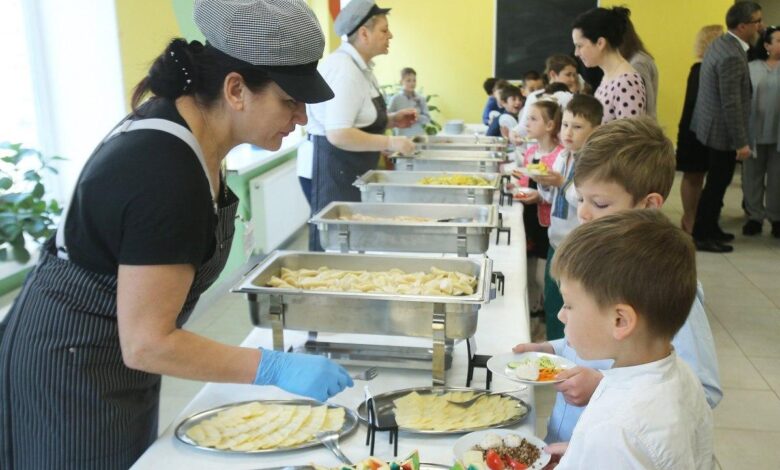The government will allocate UAH 2.8 billion for food for primary school students in 2025

Children are the most vulnerable part of society, especially during times of war when they experience stress, anxiety and loss. In such conditions, healthy nutrition becomes not just a physiological necessity, but also an important factor that supports their physical and psychological health. Regular and balanced nutrition helps children cope with stress, maintain energy and concentration in studies. It also affects the formation of healthy habits that stay with them for life. The state, understanding this challenge, is working to provide schoolchildren with quality food even in difficult conditions.
The Government of Ukraine allocates 2.8 billion hryvnias for meals for schoolchildren
The government of Ukraine plans to spend 2.8 billion hryvnias on feeding one million primary school students in 2025. About this reported press service of the Ministry of Finance of Ukraine. According to the adopted order “On the distribution of subventions from the state budget to local budgets for the provision of food for primary school students of general secondary education institutions under a special fund in 2024”, these funds will be distributed among local budgets to ensure free meals for children.
“The government adopted the order “On the distribution of subventions from the state budget to local budgets for the provision of food for primary school students of general secondary education institutions under a special fund in 2024.” Thus, UAH 2.8 billion has been allocated to local budgets for free meals for primary school students.” – says the message.
Distribution of funds between regions
The total amount of the subvention of 2.8 billion hryvnias was distributed among the regions as follows:
- Vinnytsia region will receive 151.9 million hryvnias,
- Volynska — 114.1 million hryvnias,
- Dnipropetrovsk — 186 million hryvnias,
- Zhytomyrska — 109.5 million hryvnias,
- Zakarpattia — 158.1 million hryvnias,
- Zaporizhia — 19.3 million hryvnias,
- Ivano-Frankivsk — 152.4 million hryvnias,
- Kyivska — 232.4 million hryvnias,
- Kirovohradsk — 88 million hryvnias,
- Lvivska — 281 million hryvnias,
- Mykolaivska — 58.5 million hryvnias,
- Odesa — 194.2 million hryvnias,
- Poltava — 127.7 million hryvnias,
- Rivne — 121.4 million hryvnias,
- Sumy — 52.7 million hryvnias,
- Ternopilsk — 99.8 million hryvnias,
- Kharkivska — 7.7 million hryvnias,
- Khmelnytska — 133.7 million hryvnias,
- Cherkasy — 110.2 million hryvnias,
- Chernivtsi — 99.1 million hryvnias,
- Chernihivska — 75.1 million hryvnias,
- the city of Kyiv — 263.3 million hryvnias.
These funds will provide hot breakfasts or lunches for students in elementary grades. As Deputy Minister of Finance Roman Yermolychev noted, this will allow providing children with full and high-quality nutrition, which is extremely important for the formation of their eating habits and health in the future.
Reform of school meals
The reform of school meals in Ukraine began in 2020 at the initiative of Olena Zelenska. Its main goal is to provide students of educational institutions with a balanced and healthy diet, as well as to popularize the culture of healthy eating among children and their families.
In October 2023, the government approved the Strategy for Reforming the School Food System for 2023-2027. The main goals of this strategy are to increase the financial and institutional capacity of communities, restore and modernize kitchens and canteens, comply with the requirements of the HACCP safety system, develop human resources and improve the qualifications of cooks. It is also planned to introduce new food standards and menus that meet modern standards, and to create a culture of healthy eating in Ukraine.
Reform of school nutrition requires significant financial and personnel resources. Efforts are aimed at modernizing kitchens in schools, purchasing new equipment that allows for high standards of food preparation. Special attention is also paid to training programs for cooks so that they can work according to new standards and provide children with tasty and healthy meals.
Adherence to international HACCP standards guarantees the safety of products and dishes at all stages: from the purchase of products to their presentation. The governments of the regions that receive subventions must ensure the control over the implementation of these standards so that the reform becomes effective and long-lasting.
Providing free meals to one million primary school students in 2025 will be an important contribution to the formation of a healthy generation that will be able to build the future of the country. This makes it possible to reduce social inequality, because every child, regardless of the family’s financial status, will have access to a balanced diet. In addition, children who receive hot lunches study better, because their concentration and productivity increase.





